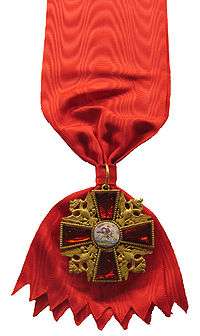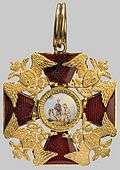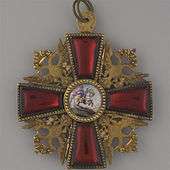Order of Saint Alexander Nevsky
| Imperial Order of Saint Alexander Nevsky | |
|---|---|
 | |
| Order on ribbon | |
| Awarded by | |
| Type | Dynastic Order |
| Royal house | House of Romanov |
| Religious affiliation | Russian Orthodox |
| Ribbon | Bright Red. |
| Motto | "For Labor and the Fatherland" |
| Awarded for | Military and Civil Merit |
| Status | Rarely constituted |
| Sovereign | Grand Duchess Maria Vladimirovna of Russia |
| Grades (w/ post-nominals) | Knight Grand Cordon, Special Class Knight/Dame Grand Cordon Knight/Dame Grand Officer Knight/Dame Grand Commander Knight/Dame Commander Knight/Dame Officer Knight/Dame Medal |
| Established | 1 June [O.S. 21 May] 1725 1725 – 1918 (National Order) 1918 - Present (House Order) |
| Precedence | |
| Next (higher) | Imperial Order of St. Catherine |
| Next (lower) | Imperial Order of the White Eagle |
| | |
| The Ribbon of the Order | |
.jpg)
The Imperial Order of Saint Alexander Nevsky was an order of chivalry of the Russian Empire first awarded on 1 June [O.S. 21 May] 1725 by Empress Catherine I of Russia.[1]
History
The introduction of the Imperial Order of Saint Alexander Nevsky was envisioned by Emperor Peter I of Russia for rewarding military bravery in battle. However, he died before he could create the order. It was established by Empress Catherine I of Russia, in memory of the deeds of Saint Alexander Nevsky, patron Saint of the Russian capital of Saint Petersburg, for defending Russia against foreign invaders. The order was originally awarded to distinguished Russian citizens who had served their country with honor, mostly through political or military service.[2]
It was first awarded on the occasion of the wedding of Grand Duchess Anna Petrovna of Russia and Charles Frederick, Duke of Holstein-Gottorp in 1725. A dozen guests received the reward, and the order quickly fell far behind the Order of Saint Andrew and the Order of Saint Catherine in prestige.[2][1]
The Empress Catherine complained about the situation and by September 1725, she took it upon herself to determine who would receive the award. The Order of Saint Alexander was granted the highest esteem and was not usually bestowed upon people below the rank of Lieutenant-General or an equal political status. Additionally it was , including Polish King Augustus II the Strong and King Frederick IV of Denmark–Norway[1]
Legacy
The Order of Saint Alexander Nevsky was abolished after the 1917 Russian Revolution, along with all other orders and titles of the Russian Empire.
In 1942, the Soviet Union revived the order as a purely military decoration and renamed it the more secular Order of Alexander Nevsky, and the Russian Federation revived it in 2010.
The heads of the Russian Imperial House in exile have continued to award the Order of St. Alexander Nevsky. HIH Maria Vladimirovna, a pretender to the Russian throne and to the headship of the Russian Imperial House, continues to award a Russian Imperial Order of Saint Alexander Nevsky as a dynastic order of knighthood.[3] These actions are disputed by some members of the Romanov family.[4]
In 2010, researchers in Saint Petersburg and Moscow published a book of all the names of the recipients of the original order. The combined number of honorees spanning the years 1725 to 1917 totaled 3,674.[5]
Insignia Order St Alexander Nevsky

Cross version, edition 1820-1830 (fron) 
... version (front) 
... (reverse) 
... edition 1865 in gold on black enamel 
Staer version from silver-thread embroidery on white leather, edition ca 1840 
... version
References
| Wikimedia Commons has media related to Order of St. Alexander Nevsky. |
- 1 2 3 Орден Святого Александра [Order of Saint Alexander] (in Russian). Retrieved 5 February 2015.
- 1 2 "Order of St. Alexander Nevsky". Kaiserzeit. Retrieved 7 September 2014.
- ↑ http://www.imperialhouse.ru/rus/dynastyhistory/honoursaward/honours/254.html
- ↑ http://www.romanovfamily.org/press.html
- ↑ Полный список кавалеров ордена святого Александра Невского издан в виде словаря [The Complete List of Recipients of the Order of Saint Alexander Nevsky Compiled in a Dictionary] (in Russian). Retrieved 5 February 2015.
